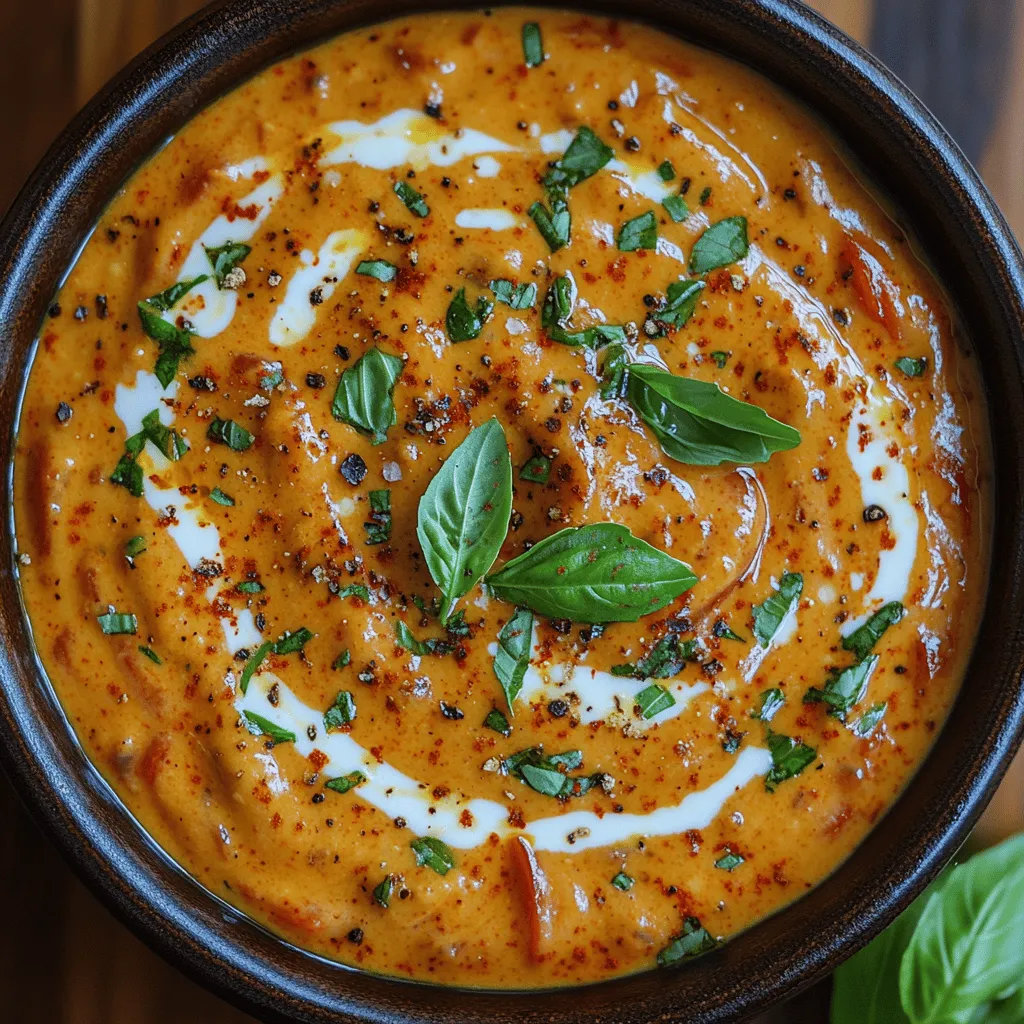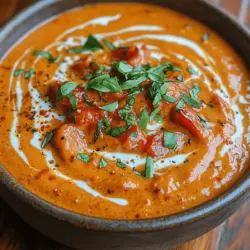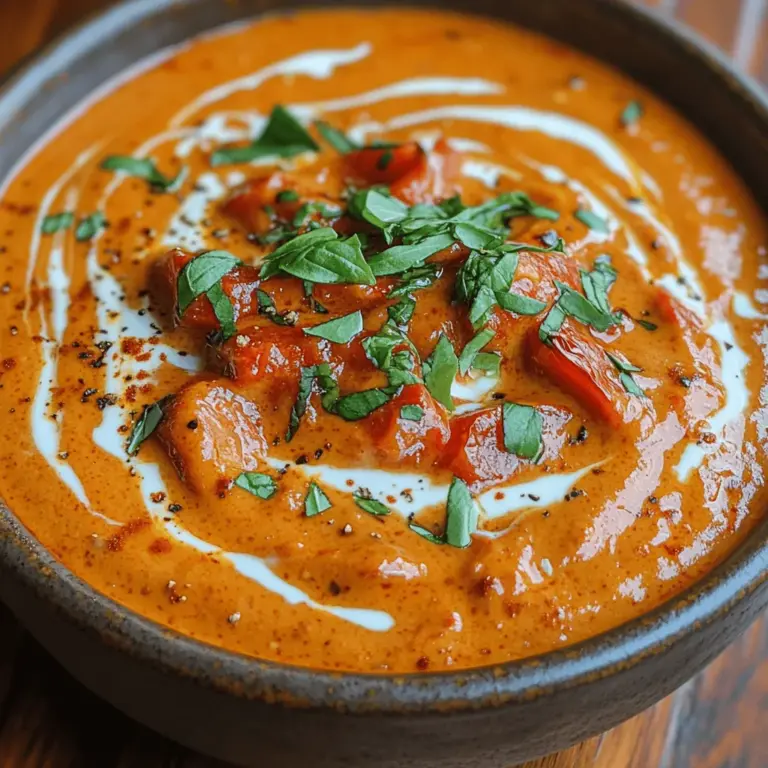Creamy Roasted Pepper Sauce: A Flavorful Journey
When it comes to sauces that elevate a dish, few can rival the rich and vibrant profile of creamy roasted pepper sauce. This exquisite sauce is a delightful fusion of sweet, charred bell peppers and luscious cream, offering a tantalizing burst of flavor that enhances everything from pasta to grilled meats. Its appeal lies not only in its creamy texture and vibrant color but also in its versatility across various cuisines, making it a must-try for home cooks looking to add a gourmet touch to their meals.
At the heart of this delectable sauce is the process of roasting. Roasting not only intensifies the natural sweetness of the bell peppers but also adds a depth of flavor that raw ingredients simply cannot match. The caramelization that occurs during roasting transforms the peppers into a smoky, sweet component of the sauce, allowing them to shine as the star ingredient. By using fresh, high-quality ingredients, you ensure that each bite is bursting with flavor and nutrition, creating a dish that is not only delicious but also wholesome.
Understanding the Ingredients
To craft the perfect creamy roasted pepper sauce, it’s essential to understand the role and benefits of each ingredient. Here’s a closer look at what goes into this sauce and how each component contributes to its overall flavor and appeal.
Fresh Red Bell Peppers
The foundation of our sauce is the vibrant red bell pepper. Packed with vitamins A and C, these peppers are not only nutritious but also bring a natural sweetness that balances the creaminess of the sauce. When roasted, they develop a smoky flavor that adds complexity and depth, making them a crucial element in this recipe. Their bright color also lends an inviting aesthetic to your dish, making it as pleasing to the eye as it is to the palate.
Aromatics: Onion and Garlic
No sauce is complete without aromatics, and for this recipe, onion and garlic are essential. Both ingredients contribute a robust flavor that enhances the overall taste profile. Onions provide a hint of sweetness that complements the roasted peppers, while garlic adds a fragrant, savory note. Additionally, both ingredients are known for their health benefits; they contain antioxidants and have anti-inflammatory properties that can contribute to overall well-being.
Heavy Cream
Heavy cream is the key to achieving that luxurious, creamy texture that makes this sauce irresistible. It binds all the flavors together while providing richness that elevates the dish. If you’re looking for lighter alternatives, options like half-and-half or even coconut cream can be used, though they may slightly alter the flavor profile. Each alternative brings its own unique characteristics, allowing you to customize the sauce to fit your dietary preferences.
Seasonings: Smoked Paprika, Salt, and Black Pepper
The seasoning blend is crucial for enhancing the flavor of the sauce. Smoked paprika, in particular, adds a warm, smoky undertone that complements the roasted bell peppers beautifully. Salt and black pepper are essential for bringing out the natural flavors of the ingredients, ensuring that every bite is well-seasoned and balanced. The right amount of seasoning can transform a good sauce into an unforgettable one.
Fresh Basil and Balsamic Vinegar
To finish the sauce, fresh basil and balsamic vinegar play pivotal roles. Fresh basil introduces a bright, herbaceous note that cuts through the creaminess, adding freshness to the sauce. Balsamic vinegar contributes a tangy sweetness that balances the richness, creating a well-rounded flavor profile. Together, they elevate the sauce from a simple accompaniment to a vibrant centerpiece.
Optional Red Pepper Flakes
For those who enjoy a bit of heat, optional red pepper flakes can be added to the sauce. This allows you to customize the spice level to your liking, making it a versatile addition to any meal. Whether you prefer a mild sauce or a fiery kick, adjusting the amount of red pepper flakes can help you achieve the perfect balance for your palate.
Preparation Steps
Now that we’ve covered the ingredients, let’s dive into the preparation process, starting with the most crucial step: roasting the bell peppers.
Roasting the Bell Peppers
Roasting bell peppers is a simple yet transformative process that enhances their flavor significantly. Begin by preheating your oven to 475°F (245°C). This high temperature is essential for achieving that beautifully charred exterior while keeping the inside tender and sweet.
1. Prepare the Peppers: Start with fresh red bell peppers. Wash them thoroughly, then cut them in half lengthwise, removing the seeds and stems. This will allow for even roasting and make it easier to peel off the skins later.
2. Arrange on a Baking Sheet: Place the halved peppers cut-side down on a lined baking sheet. This positioning maximizes contact with the hot surface, helping to develop a nice char.
3. Roast: Place the baking sheet in the preheated oven and roast for about 25-30 minutes. You’ll know they’re done when the skin is blistered and charred, and the peppers have softened.
4. Steam for Easy Peeling: Once roasted, remove the peppers from the oven and immediately cover them with aluminum foil or place them in a bowl covered with plastic wrap. This steaming process will make it much easier to peel off the skins after a few minutes. The steam loosens the skin, allowing you to remove it without much effort, revealing the beautifully roasted flesh underneath.
By following these initial steps, you’ll lay the groundwork for a creamy roasted pepper sauce that’s not only rich in flavor but also packed with nutrients. The next stage will involve blending these ingredients with the cream and seasonings to create a luxurious sauce that can elevate your favorite dishes. Stay tuned for the continuation where we’ll delve deeper into the blending process and additional ways to enjoy this versatile sauce!

Sautéing Aromatics
Sautéing aromatics is a crucial step in creating a rich and flavorful creamy roasted pepper sauce. This process helps to build the foundation of flavor that will enhance your sauce, ensuring it is not only delicious but also aromatic.
Techniques for Perfect Sautéing
To achieve the perfect sauté, begin by selecting a good quality olive oil or unsalted butter as your fat source. Heat the oil in a skillet over medium heat until it shimmers or the butter melts completely. Avoid overheating the oil, as burnt oil can impart an unpleasant taste to your sauce.
Once the fat is hot, add your finely chopped onions or shallots first. Sauté them for about 2-3 minutes until they become translucent. Next, add minced garlic to the pan. The key is to stir frequently and keep a close eye on the garlic, as it can easily burn and turn bitter. Cook the garlic for about 30 seconds until fragrant, which will infuse your sauce with a wonderful base flavor.
The Significance of Timing and Heat Control
Timing and heat control are essential in sautéing. If you add your garlic too early, it may burn before the onions are adequately softened. Conversely, if the onions are not cooked enough before adding garlic, the resultant flavor may not be balanced. Maintain a medium heat during this step to ensure even cooking, and adjust the heat as needed. If you notice the aromatics beginning to brown too quickly, reduce the heat slightly.
After sautéing, you will have a beautifully fragrant base ready for the next step in your creamy roasted pepper sauce.
Blending the Sauce
The blending process is where your roasted peppers come to life, transforming into a creamy and luxurious sauce that will elevate any dish.
Tips for Achieving the Perfect Consistency
When blending your sauce, use a high-speed blender or an immersion blender for convenience. If you choose a traditional blender, allow the sautéed mixture to cool slightly before adding it to the blender, as hot ingredients can create pressure and cause spills.
Add your roasted peppers to the blender along with the sautéed aromatics. For a creamy texture, incorporate a generous amount of heavy cream or a non-dairy alternative like coconut cream. Blend on high until smooth, stopping occasionally to scrape down the sides to ensure everything is evenly incorporated. If the sauce is too thick, you can add a splash of vegetable stock or water to reach your desired consistency.
Importance of Blending Ingredients at the Right Temperature
Blending at the right temperature is crucial for achieving a smooth sauce. If the mixture is too hot, it can become overly frothy and lose its velvety texture. Conversely, if it’s too cool, it may not emulsify properly. Aim for a warm, but not scalding, temperature when blending to create that silky sauce you desire.
Adjusting and Heating the Sauce
Once blended, it’s important to taste and adjust your sauce to ensure it meets your flavor preferences.
How to Taste and Modify Flavors
After blending, pour the sauce back into the skillet over low heat. This will allow you to warm it gently while making adjustments. Taste the sauce and consider adding salt, pepper, or even a squeeze of lemon juice to brighten the flavors. If you prefer a bit of heat, incorporating crushed red pepper flakes or a dash of cayenne can elevate the overall taste.
Suggestions for Incorporating Additional Spices
Feel free to get creative with your spices. A pinch of smoked paprika can add depth and a subtle smokiness, while fresh herbs like basil or thyme can introduce a fresh, green note. Experiment with different combinations until you find the perfect balance for your palate.
Serving Suggestions
Now that your creamy roasted pepper sauce is ready, it’s time to explore delicious ways to serve it.
Pairings with Different Dishes
This versatile sauce can complement a variety of dishes. It serves as a fantastic topping for pasta, transforming a simple bowl of spaghetti into a gourmet experience. Toss it with grilled chicken or fish for a delightful main course. It can also be drizzled over roasted vegetables or used as a dipping sauce for crusty bread or fresh veggies.
For a complete meal, consider pairing the sauce with grilled meats such as steak or pork chops. The creamy texture and rich flavor beautifully balance the savory notes of grilled proteins.
Presentation Tips
Presentation is key to making your dish visually appealing. Serve your creamy roasted pepper sauce in a beautiful bowl, garnished with freshly chopped herbs such as parsley or basil. A sprinkle of grated Parmesan cheese or a drizzle of olive oil can also add a touch of elegance. For a colorful touch, consider adding some roasted cherry tomatoes or a side of vibrant greens.
Storing and Reheating the Sauce
If you have leftover sauce, proper storage will ensure it stays fresh and flavorful.
Best Practices for Storage
Allow the sauce to cool completely before transferring it to an airtight container. Store it in the refrigerator for up to one week. For longer storage, you can freeze the sauce in portions using freezer-safe bags or containers. This method allows you to thaw only what you need for future meals.
Tips for Reheating Without Losing Texture
When reheating, do so gently to maintain the sauce’s creamy consistency. Heat it on the stove over low heat, stirring frequently until warmed through. If the sauce appears too thick, add a splash of water or stock and stir until smooth. Avoid microwaving, as this can cause the sauce to separate and lose its creamy texture.
Nutritional Information
Understanding the nutritional profile of your creamy roasted pepper sauce can help you make informed choices about incorporating it into your meals.
Overview of Calories, Fats, and Other Nutrients Per Serving
A typical serving of creamy roasted pepper sauce (about 1/4 cup) contains approximately:
– Calories: 150
– Total Fat: 12g (Saturated Fat: 7g)
– Carbohydrates: 5g
– Protein: 2g
– Fiber: 1g
Benefits of Incorporating This Sauce into a Balanced Diet
This sauce not only adds flavor but also provides nutritional benefits. Roasted peppers are high in vitamins A and C, contributing to your daily intake of essential nutrients. The use of healthy fats from olive oil or cream can help with the absorption of these vitamins, making this sauce a delicious way to enhance your meals while promoting a balanced diet.
Conclusion
In summary, the creamy roasted pepper sauce is a delightful addition to any culinary repertoire, offering versatility, ease of preparation, and a depth of flavor that can elevate a variety of dishes. Whether you use it as a pasta sauce, a topping for grilled meats, or a dip for fresh vegetables, its rich taste and creamy texture are sure to impress.
Don’t hesitate to experiment with personal variations and pairings, as the beauty of this sauce lies in its adaptability. Whether you prefer it spicy, herby, or extra creamy, this sauce provides a comforting and satisfying element to your meals. Enjoy the process of creating this flavor-packed sauce, and relish the joy it brings to your table.

